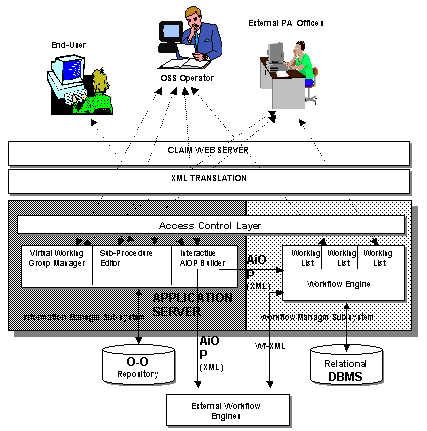Managing the Interaction between Citizens and Public Administrations:
the One-Stop-Shop Model
by Roberto Gagliardi and Paolo Fiorenzani
There are a number of European initiatives that aim at providing tools to support best value in the delivery of public services and to optimise the management of governmental operations within tight financial constraints. One of these activities is the One-Stop Shop (OSS).
The One-Stop Shop (OSS) is a service model that has been implemented by several European public administrations (PAs). The OSS acts as an interface between the citizen and the PA and is adopted for a series of both simple and complex tasks.
The TEN-Telecom project ‘CLAIM’ (Citizens and Local Authorities Interaction Management, contract no. C26398) focuses on the concept of the One-Stop Shop for business activities. This service will provide businesses with a single interface to the public administration for all those steps that have to be taken when creating a new business or industry or changing an existing one. We describe here the particular solution implemented in a pilot project aimed at validating this system in the Italian context.
A typical OSS procedure for processing a business application means involving a number of PA offices. For example, a request for authorisation to build a new factory requires approval from several offices belonging to different PA sectors: the Building Office, the Environmental Office, the Chamber of Commerce, the Health Service, the Fire Department, etc. In some cases, the offices involved have to establish a consensus-building procedure in order to be able to give a common answer to the application.
Within this framework, the OSS takes charge of:
- broadcasting the request to the offices and PAs involved
- co-ordinating the flow of the information between these bodies
- delivering the authorisations within the time constraint established by the legal framework
- making the results produced at each single step of the procedure accessible by the applicant.
CLAIM has developed an online service platform to handle these tasks. The services have been implemented on top of two basic software systems (see figure), namely: (a) the OSS Information Management System (OSS-IMS); (b) the OSS Workflow Management System (OSS-WMS).

CLAIM System architecture.
The CLAIM Solution
Data Model: The request submitted by the user (the business man) to the OSS is called the All-In-One Procedure (AiOP). The AiOP is a digital dossier composed of one or more Sub-Procedures (SP); each SP corresponds to the digital information and documents required by a single PA office involved in the AiOP before it is able to release the authorisation or opinion required of it.
System Architecture: The OSS-IMS allows users to search the document archives using a web interface and standard Internet browsers. In addition, a tool is provided, the Interactive AiOP Builder, to support the user and the OSS operator when constructing the AiOP.
The tool dynamically generates a series of questions and presents them to the user in order to guide him/her in constructing the AiOP. For each service provider (SP) identified, the Interactive AiOP Builder evaluates a set of associated Boolean rules (expressions), removing unwanted SP sets and selecting the appropriate sub-procedures to be added to the AiOP.
The AiOP structure constructed by the Interactive AiOP Builder contains not only static data but also procedural information. The CLAIM OSS-WMS engine interprets the procedural information stored in the AiOP and configures suitable flows for the processing of each SP. It generates a number of requests, which are posted in the in-box of the OSS operator and of the operators located in the PA offices involved in the AiOP. The operators access their in-box through a web interface, check whether active AiOPs need actions (SPs) to be issued by their offices and perform the required actions.
As the PAs often use local software applications to process the SPs, interoperability is a crucial requirement in CLAIM. For this reason, all the data is stored, managed and transmitted in XML format in order to guarantee exchangeability. For example, in the market-validation pilot, the CLAIM system had to interact with a pre-existing workflow application running locally on one of the PA offices involved in the AiOP processing. In this case, the XML files containing the data and the procedural information related to the SPs, which are exchanged between the OSS and external offices, were imported into the local application after the implementation of a simple interface on top of the workflow engine.
The XML structure of the AiOP is compliant with the specifications of the Workflow Management Coalition (WFMC-TC-1012, May 2000, Interoperability Abstract Specifications). This directive describes the XML dialect used to model the data transfer requirements between workflow systems.
In order to manage persistent XML objects, the information repository management is performed by a W3C compliant DOM implementation, based on the Ozone open-source object management tool. The OSS-IMS and the OSS-WMS were implemented in Java.
The user authentication is based on a digital certificate. Any data (SPs, authorisations, opinions etc.) exchanged between OSS operators and operators of external offices are digitally signed. The CLAIM system features an internal Public Key Infrastructure, which handles both software certificates (weak certification) and smart card-stored certificates enabling legal digital signatures (strong certification). Weak certification is mainly used to authenticate service users (eg, the business men), whereas strong certification is used for the exchange of legally signed documents between PA officers.
The CLAIM service platform has been tested in several European municipalities. This has permitted an overall assessment of the services and an evaluation of the best-practices.The One-Stop-Shop is now operating in the Italian towns of Pisa, Lucca, Arezzo, in Brandenbourg in Germany, in Joannina in Greece and in several other smaller towns.
Link:
CLAIM project: http://claim.cpr.it/
Please contact:
Roberto Gagliardi, CNUCE-CNR and Consorzio Pisa Ricerche
Tel: +39 050 915811
E-mail: r.gagliardi@cpr.it
or
Paolo Fiorenzani, Consorzio Pisa Ricerche
Tel: +39 050 915811
E-mail: p.fiorenzani@cpr.it
|
